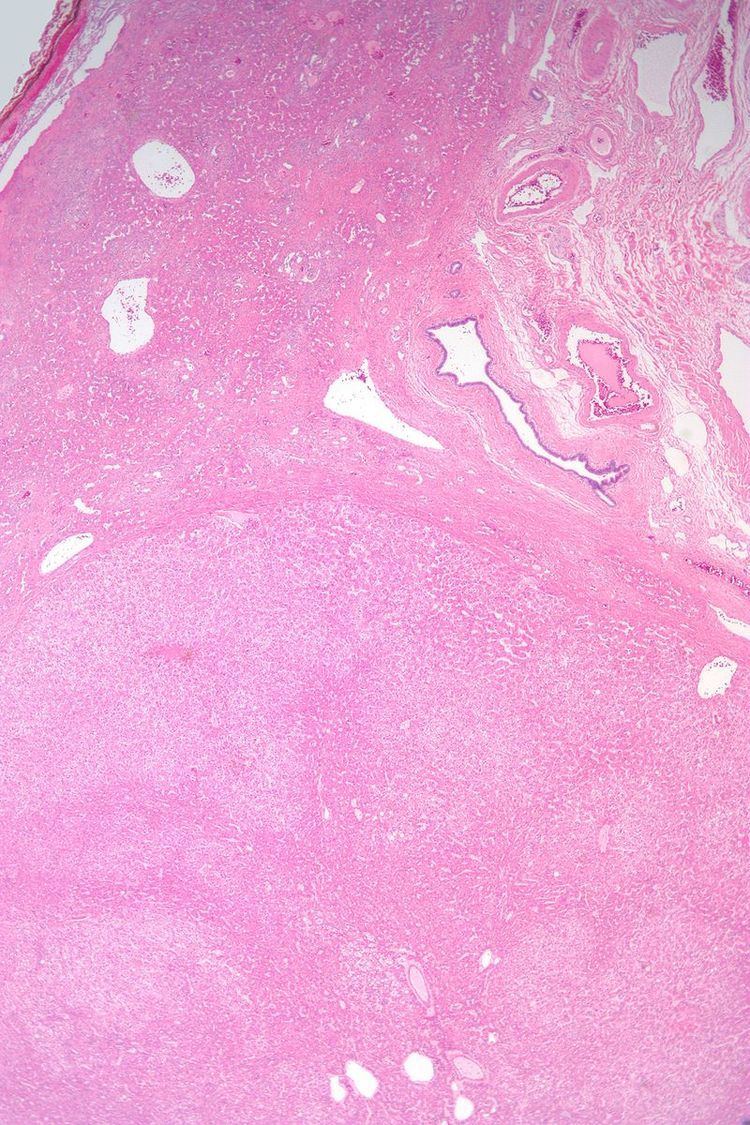ICD-O M8170/0 eMedicine med/48 | DiseasesDB 5726 MeSH D018248 | |
 | ||
Hepatocellular adenoma, also hepatic adenoma, or rarely hepadenoma, is an uncommon benign liver tumor which is associated with increased levels of estrogen. Patients of advanced age, or taking higher potency hormones, or patients with prolonged duration of use have a significantly increased risk of developing hepatocellular adenomas.
Contents
Signs and symptoms
About 25–50% of hepatic adenomas cause pain in the right upper quadrant or epigastric region of the abdomen. Since hepatic adenomas can be large (8–15 cm), patients may notice a palpable mass. However, hepatic adenomas are usually asymptomatic, and may be discovered incidentally on imaging ordered for some unrelated reason. If not treated, there is a 30% risk of bleeding. Bleeding may lead to hypotension, tachycardia, and sweating (diaphoresis).
Diagnosis
It is important to distinguish hepatic adenoma from other benign liver tumors, such as hemangiomas and focal nodular hyperplasia, because hepatic adenomas have a small but meaningful risk of progressing into a malignancy. MRI is the most useful investigation in the diagnosis and work-up. A poly-phasic CT scan is another useful test for diagnosing hepatic adenoma.
Large hepatic adenomas have a tendency to rupture and bleed massively inside the abdomen.
Radiologic differential diagnosis
Pathologic diagnosis
Hepatic adenomas are, typically, well-circumscribed nodules that consist of sheets of hepatocytes with a bubbly vacuolated cytoplasm. The hepatocytes are on a regular reticulin scaffold and less or equal to three cell thick.
The histologic diagnosis of hepatic adenomas can be aided by reticulin staining. In hepatic adenomas, the reticulin scaffold is preserved and hepatocytes do not form layers of four or more hepatocytes, as is seen in hepatocellular carcinoma.
Cells resemble normal hepatocytes and are traversed by blood vessels but lack portal tracts or central veins.
Etiology
Ninety percent of hepatic adenomas arise in women aged 20–40, most of whom use oral contraceptives.
Related Conditions
Hepatic adenomas are related to glycogen storage diseases, type 1, as well as anabolic steroid use.
Treatment
Some authors feel that all hepatocellular adenoma should be resected, because of the risk of rupture causing bleeding and because they may contain malignant cells. Current recommendations are that all hepatic adenomas should be resected, as long as they are surgically accessible and the patient is a reasonable operative candidate. Patients with adenomas should avoid oral contraceptives or hormonal replacement therapy.
Pregnancy could cause the adenoma to grow faster, so patients with hepatic adenomas should avoid pregnancy.
